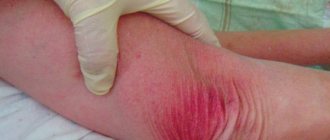Competition "bio/mol/text"-2017
This work was published in the “Free Topic” category of the “bio/mol/text” competition 2017.
The general sponsor of the competition is: the largest supplier of equipment, reagents and consumables for biological research and production.
The sponsor of the audience award and partner of the “Biomedicine Today and Tomorrow” nomination was.
"Book" sponsor of the competition - "Alpina Non-Fiction"
One monk, wandering around the world, met the Plague, which was heading to his city. -Where are you going, Plague? - he asked her. “I’m going to your hometown,” she answered. “I need to take a thousand lives there.” After some time, the monk again met Plague on his way. - Why did you deceive me then? - he asked her reproachfully. “You said you had to take a thousand lives, but you took five thousand.” “I told you the truth then,” Chuma answered. “I really took a thousand lives.” The rest died of fear.
Chastnikova V. Jewish parables. The sage is higher than the prophet [1]
The victims of the plague numbered in the hundreds of thousands and even millions of people, cities died out, entire regions became deserted, and the horror of plague pandemics eclipsed the horrors of all wars known in human history. For thousands of years, people did not understand what was the source of the disease [2].
The Bible is one of the oldest surviving accounts of plague epidemics (1 Kings, chapter 5; 2 Kings, chapter 19, verses 35–36). There have been three pandemics of this disease in world history:
- the first pandemic - the “Justinian plague” - named after the Byzantine emperor Justinian, began in Egypt (542 AD) and spread throughout the entire civilized world;
- the second pandemic - the “Black Death” (1340) - raged furiously from China to Western Europe and was accompanied by the death of about 25 million people (about a quarter of the then population of Europe), and the number of victims worldwide was estimated at 75 million people [3 ];
- The third pandemic, which originated in the Chinese province of Yunnan in 1855, spread to all inhabited continents within a few decades. In China and India alone, the total number of deaths was more than 12 million. According to the World Health Organization, echoes of the pandemic were also observed in 1959 [4].
Large outbreaks of plague are recorded with a certain periodicity (India - 1994; Madagascar - 2011 and 2013). In the USA, from 1965 to the present, up to 40 cases of human plague infection are recorded annually (an average of 10 patients per year) [5]. In Russia, in September 2014 and August 2015, for the first time in the last 35 years, two cases of human infection with plague were recorded [6], [7].
Bubonic plague is the most common form of the disease and, if untreated, leads to the death of 40–60% of those affected. The pulmonary form occurs either as a complication of bubonic or septic forms, or when inhaling air contaminated with the plague pathogen. If treatment is not started within the first 24 hours after the onset of symptoms, death occurs within 48 hours [8].
In nature, the plague microbe is found on almost all continents, with the exception of Australia, Antarctica, and the Arctic, which leads to annually recorded cases of this disease. The rapid evolution of microorganisms leads to the emergence of populations of bacteria (strains) resistant to antibiotics [9], which is especially dangerous in the case of the plague pathogen. In addition, these bacteria can be used as an agent of bioterrorism. All of the above explains the need to study the plague microbe.
The causative agent of plague, Yersinia pestis, is the most dangerous bacterium in the world [10]. What makes it so deadly?
Forms of the disease
There are several known forms of the disease, which differ from each other in symptoms and degree of contagiousness:
- Bubonic - after infection penetrates through a wound on the skin, the lymph node becomes inflamed.
- Pulmonary - pneumonia that occurs when the plague bacillus enters the respiratory tract.
- Septic (“fulminant”) - the pathogen can enter the body both through the skin and through the mucous membranes. Fever occurs several hours after infection. Death occurs on the same day.
- Skin - the infection enters through a wound or scratch, but does not cause inflammation of the lymph node (bubo).
- Intestinal - a complication of any of the forms.
All these varieties are equally dangerous to health and have always led to inevitable death in the past.
Virulence factors, or armed and very dangerous
Any pathogenic bacteria must have a number of properties: “abilities” for invasion (invasion), colonization, resistance to the host’s immune reactions and toxicity. Biomolecules that perform these functions are called pathogenicity (virulence) factors.
Since the discovery of the plague causative agent in 1894 by the Frenchman Alexandre Yersin and the Japanese Kitasato Shibasaburo, scientists have been trying to figure out what determines the pathogenicity of Y. pestis. As a result of many years of hard and risky work, which continues to this day, the following pathogenicity factors have been identified:
- outer membrane proteins (Yersinia outer proteins—called Yop proteins, effector proteins, or the Yop-virulon complex) [11];
- pigmentation area complex [12];
- plasminogen activator [13];
- capsular antigen [14];
- pili adhesion or pH6 antigen [15].
Proteins of the outer membrane, or why does the plague pathogen need a syringe?
The study of individual Yop proteins, namely V- and W-antigens, began back in 1956 [16]. YopM, YopN, YopH, YopE, YopD and other proteins have also been described [17]. They suppress the development of immune reactions, in particular, phagocytosis, and when microbes are “swallowed” by macrophages (immune cells), they ensure the multiplication of the pathogen inside macrophages [11]. Outer membrane proteins are synthesized only at a temperature of 37 °C and under conditions of calcium ion deficiency (low calcium response) [18]. The mechanism of action of Yop proteins—type III secretion system—was discovered at the end of the last century [19]. According to this mechanism, a plague microbe, approaching a eukaryotic cell, injects effector proteins into the cytoplasm (according to the principle of a syringe with the formation of a special channel - a “needle”) (Fig. 1) [20]. Scientists pay special attention to the V-antigen, since it is used to create a chemical vaccine against plague [21].
Figure 1. Diagram of the action of the type III secretion system.
[19]
Complex area of pigmentation, or can the need for something become a factor of pathogenicity?
During laboratory work, researchers found that the plague microbe can become avirulent (safe) for mice. When such bacteria are sown on nutrient media with hemin (an iron-containing substance formed by the action of hydrochloric acid on hemoglobin), they form uncolored colonies, in contrast to pigmented colonies of virulent strains. This is how one of the simplest ways to determine the virulence of plague pathogen strains without the use of laboratory animals appeared. If a bacterial population on a medium with hemin (Jackson-Burrows medium) “gives” the growth of pigmented colonies, then it is dangerous (virulent), if unpigmented, then it is not dangerous (avirulent) [22].
Subsequently, it turned out that the genes of the hms locus of the pigmentation region on the bacterial chromosome are responsible for the color of virulent colonies. This pigmentation region also contains the Y. pestis pathogenicity island, HPI. What is remarkable about the genes of this island and why was it given such a meaningful name? It turns out that iron ions Fe3+ are necessary for the life of the plague bacterium. The capture and transport of Fe3+ into the cell is carried out by low molecular weight molecules with a high affinity for iron - siderophores [23]. The genes encoding siderophores form the pathogenicity island. At least one siderophore system, namely the yersiniobactin protein synthesis and transport system, provides active iron transport in Yersinia. However, the entire pigmentation region is extremely unstable and can be spontaneously deleted from the chromosome. The loss of the siderophore system from the genome leads to a significant decrease in the virulence of the plague pathogen [24]. Therefore, the need for iron began to be considered as a determinant of the virulence of the plague microbe. And since deletion of the pigmentation region also removes the hms locus, which encodes the pigment sorption trait, they began to separate dangerous and non-dangerous Yersinia populations using this “mark.”
Plasminogen activator, or two-faced Janus
Much attention is paid to omptins, a family of outer membrane proteases that perform many functions in the bacterial cell, including the transport of various substances across the outer membrane, and, in general, contribute to the adaptation of the microorganism to environmental conditions. One of them is plasminogen activator (Pla) [25]. Even before Pla was isolated, experts came to seemingly contradictory conclusions. On the one hand, the plague microbe coagulates blood plasma (plasma-coagulating activity), on the other hand, it prevents the formation of a blood clot (fibrinolytic activity). It is all the more surprising that both of these activities, as later turned out, are possessed by the same protein—plasminogen activator. It turned out that at temperatures below 30 °C Pla exhibits plasmacoagulating activity. In the proventriculus of an infected flea (a carrier of plague microbes), the blood coming from a rodent sick with plague coagulates and a “block” is formed - a reservoir for the reproduction of Yersinia. In this case, a hungry flea begins to actively bite an animal or person without feeling full. When a fresh portion of blood arrives, the pathogen with the flea’s “belching” penetrates the wound and infects it. Once in another environment with a temperature of 36–37 ° C - the temperature of a human body (or slightly higher - a warm-blooded animal), the plasminogen activator begins to act in exactly the opposite direction: it exhibits fibrinolytic activity - it prevents the formation of a blood clot at the site of the bite and thereby ensures the spread pathogen [26].
The article “Black Death. The story of how a harmless bacterium became a merciless killer" [35]. - Ed.
When plague microbes are inhaled (and the development of pneumonic plague), this protein ensures the rapid proliferation of bacteria in the lung tissues and leads to the development of fulminant pneumonia and pulmonary edema, whereas in the absence of Pla the infection does not develop into fatal pneumonia. It has been established that plasminogen activator disrupts the constancy of the internal environment of the host body and blocks immune reactions aimed at destroying the pathogen [27].
Capsular antigen, or slippery type, this plague pathogen
The bacteria are surrounded by a capsule of mucous substance (fraction I, Fra1), which prevents the absorption and neutralization of Y. pestis by the host immune cells during the process of phagocytosis. Many modern methods of laboratory diagnosis of plague are based on the identification of this antigen substance; it is part of many experimental chemical vaccines against plague. However, bacterial populations lacking a capsule were later discovered [28]. In addition, many other microorganisms have a mucous capsule, for example, the causative agent of anthrax and tularemia. The capsular substance of Yersinia is formed at a temperature of 37 °C.
Pili adhesion (pH6 antigen), or "agent 007"
The specific antigen pH6 (adhesion pili - small villi, PsaA protein) is also synthesized only at a temperature of 37 ° C, but there is one more condition - pH below 6.4 (which is reflected in its name). It is believed that this pH value is close to the pH of lysosomes of macrophages or the necrotic contents of abscesses, where this antigen is probably synthesized. The pH6 antigen is responsible for the attachment of plague microbes to the epithelial cells of the respiratory tract and their colonization. This antigen is also interesting because it suppresses phagocytosis: when Yersinia enters the blood, pH6 antigens combine with plasma apolipoprotein B, which makes bacterial cells “invisible” to macrophages [29]. Consequently, in an initially aggressive warm-blooded organism of the host, populations of the plague microbe with the pH6 antigen have a greater chance of survival than populations of the plague pathogen without the pH6 antigen—a phenomenon of selection of PsaA+ bacteria [30]. In natural plague foci, only Y. pestis strains with pH6 antigen are isolated.
Antigens similar to pH6 were found in a number of pathogens that cause less dangerous diseases - intestinal infections (Y. pseudotuberculosis [31], Y. enterocolitica [32], Escherichia coli [8]).
City under siege
View of the town hall in Marseille during the great plague of 1720. Michelle Serre. 1721 Musée des Beaux-Arts de Marseille
The plague-ridden city quickly turns into a besieged fortress. But he is besieged not only from the outside, but also from the inside. His enemy is infection. And everyone who is still healthy has a potential enemy - anyone who is already sick. Neighborhoods, streets, houses, people - the city breaks up into many small fortresses fighting for survival. The history of epidemics, during which death sweeps away all conventions, exposes the fragility of social ties.
Sometimes it seems that if you don’t notice the danger, it will pass by. In many cities, when the first cases appeared, residents did not want to believe that the plague had returned. The authorities delayed introducing quarantine and other restrictions, fearing to provoke panic, cut off the city from food supplies and collapse its finances. What if it’s not a plague after all? What if the doctors are mistaken or are deliberately intimidating everyone about the epidemic in order to profit at the expense of their fellow citizens? What if the pestilence passes?
In 1599, when the plague was raging throughout the north of Spain, doctors in Burgos and Valladolid, not wanting to admit the obvious, made evasive diagnoses: “This is not really a plague,” “We are talking about tertiary and double fever, diphtheria, fever, stitches in the side, catarrh, gout and similar diseases... Some patients have buboes, but they are easily cured.” Alas, many of the buboes did not last, and Burgos and Valladolid were devastated. The epidemic is almost always “foreign”. It comes from foreign lands, and maybe even sent from there. In Lorraine in 1627 the plague was called “Hungarian”, and in 1636 - “Swedish”; in Toulouse in 1630 - “Milanese”.
Saint Macarius of Ghent gives Holy Communion during the plague. Jacob Van Ost the Younger. 1673 Musée du Louvre
The pestilence was doubly destructive: it devoured not only the cells of the body, but also the cells of society. When collective prayer services and religious processions could not appease the angry God, religious zeal gave way to disunity. After all, a stranger who prays next to you risks becoming your unwitting killer. Witnesses of the epidemic in Florence (1348), Brunswick (1509), London (1664–1665), Marseilles (1720), as if from a carbon copy, described how parents abandon sick children, children run away from their parents, husbands betray their wives, and wives forget about husbands. During the Milanese plague of 1630, some townspeople went out into the streets, armed with a pistol, so that no one would dare to approach them. The plague swept away the usual way of life and urban order. Almost always during a pestilence, there were rumors that plague inspectors were robbing houses, and gravediggers, in order not to return to the same house twice, threw people into their carts and buried those still alive.
“...The disaster instilled such horror in the hearts of men and women that brother left brother, uncle of nephew, brother’s sister, and often husband’s wife; Moreover, and more incredible: fathers and mothers avoided visiting their children and following them, as if they were not their children. For this reason, men and women who fell ill, and their numbers cannot be counted, had no other help left except the mercy of friends (there were few of them) or the greed of servants attracted by large, out-of-measure salaries; and there were not many of them, and they were men and women of a rude disposition, not accustomed to this kind of care, who did not know how to do anything else but give the sick what they needed, and look after them when they ran out; While serving such service, they often lost their lives along with their earnings.”
Giovanni Boccaccio. "Decameron"
In some cities, priests and doctors, whose mission was to console the desperate and care for the incurable, abandoned churches and hospitals. In others, they stayed to fulfill their duty and died along with the sick and their flock. In Perpignan in 1348, six doctors out of eight died, in Florence - 78 cordillera monks out of 150. In Milan, during the epidemic of 1575, Archbishop Carlo Borromeo remained in the city and consoled the sick in hospitals. His nephew Federico, who also became an archbishop, did the same thing 55 years later. But there were also many church hierarchs who fled from the plague, leaving their parishioners behind.
The proximity of death often led to psychological extremes: the apathy of hopelessness was replaced by unbridled joy, and mourning by revelry. Since the end is on the threshold, you need to have time to enjoy life. Moralists castigated contemporaries who indulged in gambling and debauchery in the midst of the spectacle of death. And in Paris in 1401, the Dukes of Burgundy and Bourbon created the “court of love” (cour amoureuse). It was a kind of club or courtly community, intended for joint feasts and literary exercises in honor of the ladies. His goal was to “pass the time with grace and find new joy in life” during the “difficult time of the plague.”
Sheltered from the Florentine plague in the church of Santa Maria Novella. Miniature by Taddeo Crivelli for “The Decameron” by Giovanni Boccaccio. 1467 Bodleian Lipary, Oxford
It was possible to find a scientific basis for earthly joys. Many doctors of the 16th and 17th centuries argued that apathy and fear greatly increased the risk of infection, and therefore prescribed moderate entertainment, music and pleasant reading as medicine. At times, city authorities even organized public festivals in the midst of the epidemic in order to prevent hopelessness from taking precedence over hope. When the plague subsided, many cities were gripped by wedding fever: people who had lost their families hurried to get married in order to forget about the horror of death. According to some reports, in Cologne, shortly after the plague of 1451, which killed more than 20 thousand people, 4 thousand marriages took place.
“Some believed that a moderate life and abstinence from all excesses greatly help in the fight against evil; having gathered in circles, they lived, separated from others, taking refuge and locking themselves in houses where there were no sick people... they spent time among music and the pleasures that they could provide themselves. Others, carried away by the opposite opinion, argued that drinking and enjoying a lot, wandering around with songs and jokes, satisfying, if possible, every desire, laughing and mocking everything that happens - this is the surest cure for the disease. And as they said, they carried it out to the best of their ability, wandering day and night from one tavern to another, drinking without restraint and measure, most often arranging this in other people’s houses, just so they would hear that there was something there to their taste and taste. pleasure".
Giovanni Boccaccio. "Decameron"
Temperature factor, or what really matters
It is necessary to focus on the special role of temperature in the physiology of the plague microbe. It is at a temperature of 37 °C that its nutritional needs increase [33] and almost all known virulence determinants are synthesized (Fig. 2) [34]. In other bacteria, this dependence is less pronounced, which suggests the leading role of the temperature factor in the virulence of the plague pathogen [8].
Figure 2. “Protein portraits” of a plague microbe grown at temperatures of 28 and 37 °C, respectively.
[34]
"I believe it, I don't believe it"
There are many rumors and myths surrounding Y. pestis. For example, the bacterium was considered the culprit of the “Plague of Athens” - an epidemic that swept through Ancient Athens in the second year of the Peloponnesian War. The influx of refugees into the Greek city caused overpopulation and overcrowding, which undoubtedly contributed to unsanitary conditions: there was no time to monitor hygiene, since the main forces were aimed at achieving military superiority over the enemies. Under these conditions, an epidemic of “plague” arose, perceived by the Greeks as divine punishment for the family curse of the Alcmaeonids. Nevertheless, modern studies prove that Y. pestis was not involved in the epidemic in Ancient Greece. Using molecular genetic analysis, it was established that the teeth* found in the burials of victims of the Athenian epidemic did not contain DNA of the plague bacillus, but contained DNA of the bacterium Salmonella typhi, the causative agent of typhoid fever [10].
* — You can read more about how DNA is extracted from teeth in the article “Mammoths, bones and drug resistance: new technologies make it possible to study the evolution of infectious disease agents” [11].
Further controversy arises around the “helpers” in the spread of Y. pestis. The disease is transmitted by fleas, and fleas are transmitted by rodents. It was believed that European rats (Fig. 4), once infected with plague, served as a reservoir of infection for several centuries, but this fact is now disputed by Norwegian scientists. Nils Christian Stenseth from the University of Oslo explains that outbreaks of plague should be associated with weather fluctuations: especially warm and humid spring-summer periods are characterized by rapid development of plants and an abundance of food, the number of rodents in such years increases significantly, which means and the plague spreads faster. A study of ancient records of climate change in Europe and Asia during pandemics led to the conclusion that in Europe the onset of epidemics did correspond to favorable natural conditions, but only... in Asia and with a stable delay of about 15 years. This allowed us to conclude that the plague bacillus was not hidden in European rats for many centuries, but was imported by traders from Asia again and again. True, this hypothesis still requires strict scientific confirmation - Stenseth plans to conduct a genetic analysis of the remains of victims of European plague outbreaks and compare the genomes of the pathogens [12].
Figure 4. Rats (Rattus norvegicus) are carriers of fleas and, therefore, the plague bacillus. Figure from [12].
Genome or everything important inside
Modern technologies have made it possible to decipher the genome of the plague microbe, which, as it turned out, has more than 98% similarity with the relatively harmless bacterium Y. pseudotuberculosis, the evolutionary predecessor of the plague causative agent (an event 5-7 thousand years ago) [35]. Interestingly, the acquisition of the unique virulence of Y. pestis was accompanied by the loss of some genes. For example, the loss by a plague microbe of the gene encoding adhesin A (YadA), one of the most important virulence factors of the pathogen pseudotuberculosis, leads to blocking the formation of extracellular neutrophil traps, the most effective process of pathogen destruction at present [36]. Neutrophil leukocytes in the absence of adhesin A cannot form a “catching net” from their own DNA and proteolytic enzymes, trap bacteria in it and break them down [37]. The plague causative agent also has a “poorer” set of genes for the Yop-virulon effector proteins than other representatives of the Yersinia genus [8].
Read about sequencing the genome of Yersinia, which caused the Black Death of 1340, in the material “It’s a Plague” [3]. - Ed.
In addition to the chromosome, the plague microbe has plasmids—extrachromosomal sections of DNA [38]. Most protein virulence factors are encoded on plasmids: effector proteins on the pCad plasmid; capsule - pFra; plasminogen activator - pPla (pPst, pPCP). Plasmids pFra and pPla are found only in Y. pestis (species-specific), pCad is common with the causative agent of pseudotuberculosis (genus-specific) [20].
Treatment
The patient is placed in a separate box located in the infectious diseases hospital. Doctors immediately notify the sanitary and epidemiological station of all cases of illness. To examine and contact infected people, doctors and nurses must wear anti-plague suits and other protective equipment. For treatment, anti-plague serum is used, as well as all kinds of sulfonamides and antibiotics. An intensive care doctor works with patients who have a septic or pulmonary form.
In previous centuries, death from the plague was inevitable. There are patients with this infection even in our time, but with the help of modern medicines they have a great chance of surviving and recovering. To protect yourself from infection, you need to wash your hands, practice good hygiene and not eat meat without sufficient heat treatment.
Literature
- It's better to see once, or Ultra-high-resolution microscopy;
- Beyond the diffraction barrier: Nobel Prize in Chemistry 2014;
- Plague. The Black Death. National Geographic website;
- Bibel D. J. and Chen T. H. (1976). Diagnosis of plaque: an analysis of the Yersin-Kitasato controversy. Bacteriol. Rev. 40 (3), 633–651;
- Suntsov V.V. and Suntsova N.I. Plague. Origin and evolution of the epizootic system (ecological, geographical and social aspects). M.: KMK, 2006. - 247 p.;
- Zimbler DL, Schroeder JA, Eddy JL, Lathem WW (2015). Early emergence of Yersinia pestis as a severe respiratory pathogen. Nature. 6, 7487;
- Caulfield AJ, Walker ME, Gielda LM, Lathem WW (2014). The Pla protease of Yersinia pestis degrades fas ligand to manipulate host cell death and inflammation. Cell Host Microbe. 15 (4), 424–434;
- Fleas. Illinois Department of Public Health website;
- Zilber L.A. (1966). Operation "ORE". Science and life. 12;
- It's a plague;
- Mammoths, bones and drug resistance: new technologies allow studying the evolution of infectious disease agents;
- Attic: “European rats turned out to be innocent in medieval plague epidemics.”
List of sources
- Supotnitsky M.V., Supotnitskaya N.S. Essays on the history of the plague: In 2 books. - Book I: Plague of the prebacteriological period. - M.: University Book, 2006. - 468 p.
- Bryukhanova G.D. Current aspects of the epidemiology and microbiology of plague in modern conditions: Dissertation of the Doctor of Medical Sciences. – 2004.- M.- 250 S.
- Anisimov A.P. Factors of Y. pestis that ensure the circulation and preservation of the plague pathogen in the ecosystems of natural foci // Molecules, genetics. 2002. - No. 3. - P. 3 - 23.
- Innokentyeva T.I. Modern aspects of plague surveillance // Journal. infectious pathol. 1997. - T. 4., No. 1. - P. 8 - 14.
- Nikiforov V.V., Avdeeva M.G., Namitokov H.A. Plague. Educational and methodological manual. 2021. - 121 p.
Popular message topics
- The Tale of Bygone Years
The Tale of Bygone Years was conceived by the chronicler Nester at the beginning of the 12th century. He served as a monk in the Kiev-Pechersk Lavra, and is the first chronicler in Rus'. He was endowed with modesty, holiness and a special gift from God. - History and inventions of steam engines
The very first steam engine was described by the Greek scientist Heron of Alexandria. The model was described as pneumatic. The design was a bronze cauldron with water inside. The boiler stood on supports, covered with a lid on top. Two are attached above the lid - Gzhel
Art has always been a part of our life, and even now it is an integral part of it. Art was comprehended by our distant ancestors and continues to be practiced by our contemporaries. Since then, many new types of art have appeared, such as painting,
Anti-epidemic measures
Identification of a plague patient is a signal for the immediate implementation of anti-epidemic measures, which include:
- carrying out quarantine measures;
- immediate isolation of the patient and preventive antibacterial treatment of service personnel;
- disinfection at the source of the disease;
- vaccination of persons in contact with the patient.
After vaccination with an anti-plague vaccine, immunity lasts for a year. Re-vaccinate after 6 months. persons at risk of re-infection: shepherds, hunters, agricultural workers and employees of anti-plague institutions.
Rice. 31. In the photo, the medical team is dressed in anti-plague suits.









